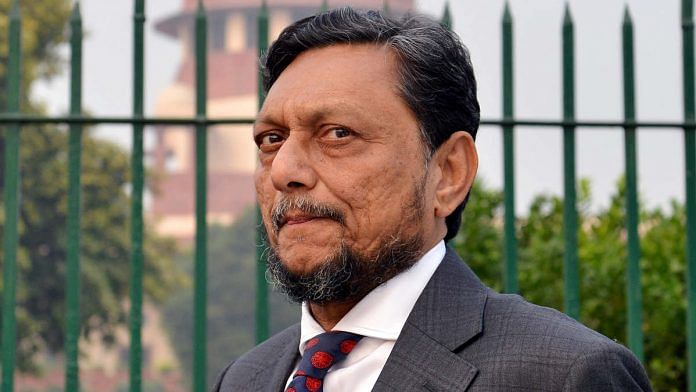Even before the imposition of a national lockdown on 24 March 2020 to fight the spread of Covid-19 in India, the Supreme Court of India had started taking measures to limit the gathering of people indoors. While only “urgent matters” were being heard initially during the lockdown, as restrictions eased and lawyers and judges alike grew more comfortable with online hearings, the number of cases being heard by the Court increased likewise.
A recent press release issued by the Supreme Court on the occasion of the 71st anniversary of its first sitting noted that the Court was functional for 231 days in the calendar year 2020; beyond the usual minimum of 190 days. The press release also notes that the Court had held 43,713 hearings through videoconferencing as of 31 December 2020.
While the efforts of the judges, lawyers and the Supreme Court registry are commendable, one must examine whether this avoided the piling up of the backlog of cases. Since 2012, the Court has been putting out monthly statements on the number of cases pending in the Court and one can assess if the measures were sufficient to prevent the piling up of cases. Comparing the pendency position between 1 March 2020 and 1 March 2021 should tell us how the Court’s measures to function in the time of Covid-19 have fared. Likewise, comparing this data for the previous year will also give context to the Court’s performance.
Also read: CJI Bobde recommends Justice NV Ramana as successor
Pendency data
The monthly statement which gives the number of pending cases as on date breaks them up into two categories: admission/miscellaneous matters and regular hearing matters. “Miscellaneous matters” are those which have been filed in the Court and the Court has not yet decided to take them up for full hearing. Regular matters are those which the Court has decided it will take up for a full hearing (Robinson 2013). These two broad categories are further divided into two categories each: miscellaneous into “complete” and “incomplete,” and regular into “ready” and “not ready.”
“Miscellaneous complete” and “ready regular” matters are those where all the preliminary steps have been completed by the parties and the matter is in the queue waiting for a hearing date. “Incomplete miscellaneous” and “not ready regular” matters are those where preliminaries are not completed by the parties. These preliminaries vary in cases of “miscellaneous” and “regular” matters but include such steps as service of notice, filing of statement of case, etc.
In short, “complete” and “ready” matters are only pending action on the part of the Court and registry to list the case for hearing, whereas “incomplete” and “not ready” matters are awaiting action on the part of parties. A steady increase in “incomplete” and “not ready” matters would show that parties are being lax about carrying out their procedural responsibilities in pursuing a matter whereas an increase in “complete” and “ready” matters would suggest that the Court is unable to list and hear matters sufficiently quick enough to prevent a backlog from building up.
Also read: Don’t just blame India’s courts, it’s the police that can’t solve criminal cases in time
What does the data say?
As on 1 March 2021, there were 66,727 matters pending in the Supreme Court. This is the highest number since monthly statements started being published in 2012, and possibly the highest since the early 1990s. However, the same figure was 60,469 on 1 March 2020, suggesting that the number of cases pending in the Supreme Court has increased by 6,258 over 12 months. This amounts to a 10.35% increase in the number of pending matters. The increase has been slow and steady over the course of the year as Table 1 shows.
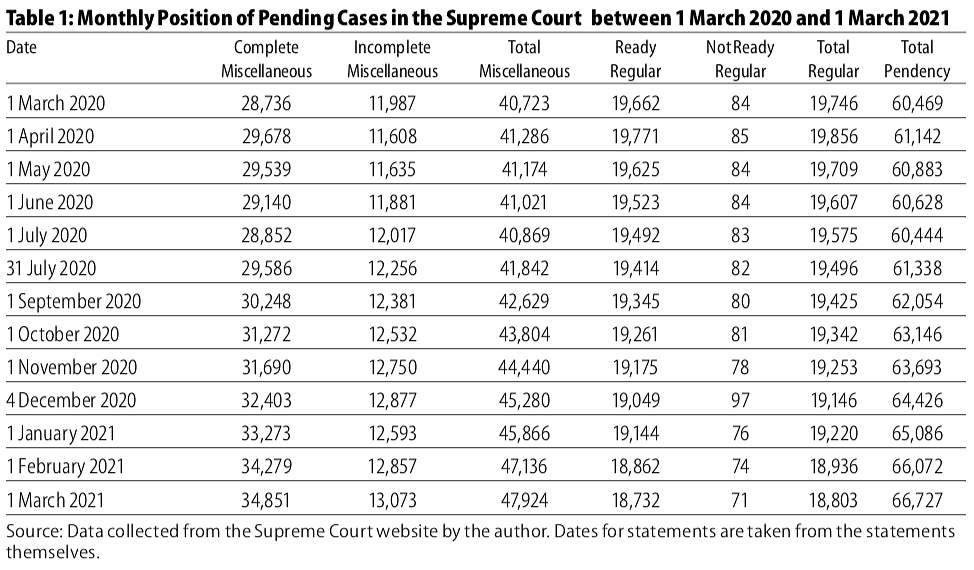
These numbers point to certain observations. While the Court has been able to reduce the number of pending regular matters over the year, it has been unable to do the same for miscellaneous matters. This is possibly due to the fact that far fewer miscellaneous matters have been listed for online hearings than they were when hearings were done in person. (For instance, in the pre-pandemic days, Mondays and Fridays saw 50 to 70 miscellaneous matters listed before each bench, whereas post pandemic, the number has come down to about 25–35.) The opposite trends for complete miscellaneous matters and ready regular matters are seen clearly in Figure 1.
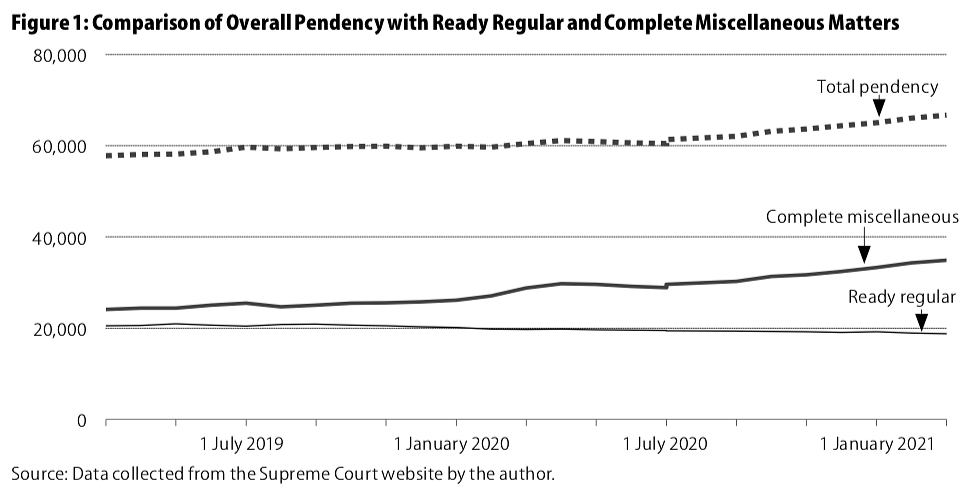
However, while the number of pending miscellaneous cases increased by 17.68%, for pending regular cases, it actually dropped by 4.78%. Did Covid-19, therefore, contribute to a sudden rise in pendency in the Supreme Court?
Table 2 shows the pendency position between 1 March 2019 and 1 March 2020, the 12 comparable months prior to the pandemic.
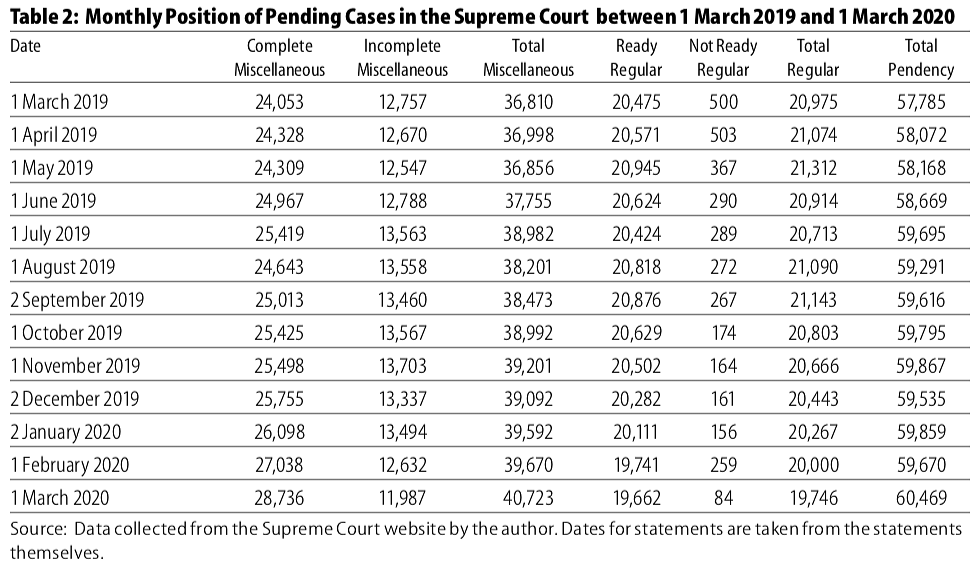
While there is an increase in the number of pending cases in these 12 months as well, the pattern is similar to what is seen in 2020–21: an increase in the number of pending complete miscellaneous cases and decrease in the number of pending regular cases. However, there is a significant difference in the magnitude of the increase between 2019–20 and 2020–21. The comparison is given in Table 3.
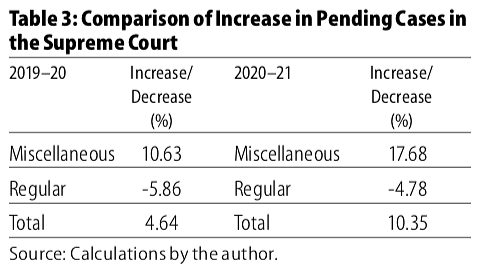
What these numbers suggest is that even prior to the Covid-19-inspired measures hampering the full functioning of the Supreme Court, the number of pending cases had been growing for the past year, but the lack of full functioning has meant that the rate of increase of pending cases has gone up.
Also read: Indian judges are overburdened, looking after legal aid shouldn’t be on their plate too
Challenges for the next CJI
The present Chief Justice of India (CJI) S.A. Bobde will demit office on 23 April 2021, leaving him little time to address the concerns of pending cases. When he retires, the Supreme Court will be down to 28 judges; five fewer than the number of judges when he became CJI in November 2019. One possible explanation for the increase in pending judges might have to do with the falling judge strength; all the four judges who retired during CJI Bobde’s tenure did so in the last 12 months. However, even when the Supreme Court was almost at full strength between 2019 and 2020, we see an increase in the number of pending cases.
Nevertheless, filling up vacancies may allow for the constitution of more benches of the Court and speed up disposal of cases to some extent. While the functioning of the collegium was not seriously affected during the pandemic, no judges have been appointed to the Court since September 2019. The 540 days (and continuing) gap between appointments to the Court is the longest in the last decade and has been attributed to an impasse in the collegium. (The longest gap prior to this was 501 days in 2010 and 2011 during the tenure of CJI S.H. Kapadia.)
Even if the impasse is broken and appointments made quickly in the coming days, if the experience of 2019–20 is anything to go by, it may only slow down, but not entirely reverse the growth of pending cases in the Supreme Court. Keeping a check on the concerning rise in the number of pending cases in the apex court may require some deep reforms on the part of the institution.
Alok Prasanna Kumar is Co-Founder and Lead, Vidhi Karnataka. Views are personal.
This article was first published by the Economic & Political Weekly (EPW).


